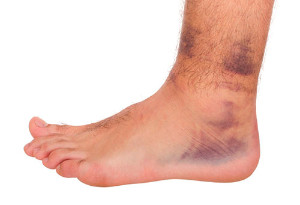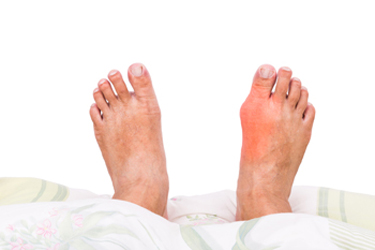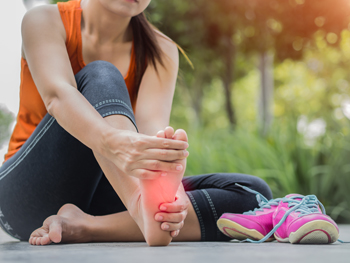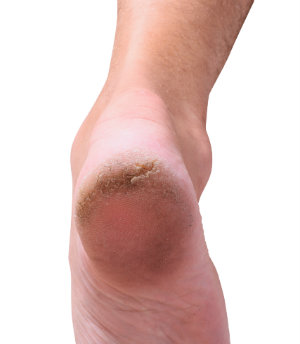
Wilmington (937) 382-2347
Fax
(513) 932-1606

Wilmington (937) 382-2347
Fax
(513) 932-1606
 If you should endure an injury that tears the ligaments in the ankle, you may have what is known as an ankle sprain. A common symptom that is associated with this condition is severe pain while attempting to walk on the affected ankle. Additionally, the ankle can appear bruised and swollen. Research has indicated it is beneficial to start treatment as quickly as possible after the injury has occurred. This consists of resting the foot while elevating it above heart level, and wrapping the ankle with an elastic bandage. It may be necessary to strengthen the ankle before returning to any type of sporting activity. These exercises include toe raises, resistance movements, and balancing motions. If you have sprained your ankle, it is advised that you seek the counsel of a podiatrist who can guide you toward the correct treatment.
If you should endure an injury that tears the ligaments in the ankle, you may have what is known as an ankle sprain. A common symptom that is associated with this condition is severe pain while attempting to walk on the affected ankle. Additionally, the ankle can appear bruised and swollen. Research has indicated it is beneficial to start treatment as quickly as possible after the injury has occurred. This consists of resting the foot while elevating it above heart level, and wrapping the ankle with an elastic bandage. It may be necessary to strengthen the ankle before returning to any type of sporting activity. These exercises include toe raises, resistance movements, and balancing motions. If you have sprained your ankle, it is advised that you seek the counsel of a podiatrist who can guide you toward the correct treatment.
Ankle sprains are common but need immediate attention. If you need your feet checked, contact Dr. Gerald Perelman from Ohio. Our doctor can provide the care you need to keep you pain-free and on your feet.
How Does an Ankle Sprain Occur?
Ankle sprains take place when the ligaments in your ankle are torn or stretched beyond their limits. There are multiple ways that the ankle can become injured, including twisting or rolling over onto your ankle, putting undue stress on it, or causing trauma to the ankle itself.
What Are the Symptoms?
Preventing a Sprain
Treatment of a Sprain
Treatment of a sprain depends on the severity. Many times, people are told to rest and remain off their feet completely, while others are given an air cast. If the sprain is very severe, surgery may be required.
If you have suffered an ankle sprain previously, you may want to consider additional support such as a brace and regular exercises to strengthen the ankle.
If you have any questions please feel free to contact our office located in Wilmington, OH . We offer the newest diagnostic and treatment technologies for all your foot and ankle needs.
 The condition known as gout typically causes severe pain and discomfort. It is a form of arthritis and affects the joints at the base of the big toe. The symptoms that accompany gout often include swollen joints, in addition to the affected portion of the foot becoming tender and red. Gout develops as a result of excess uric acid in the blood, and this can cause crystals to form in the joints of the big toe. Patients who take specific medications that include diuretics and low dose aspirin may be susceptible to gout attacks. Eating certain foods in excess that have high purine levels may cause gout to occur. These include red meat, shellfish, and alcohol. If you have developed gout, it is strongly advised that you seek the counsel of a podiatrist who can properly treat this condition.
The condition known as gout typically causes severe pain and discomfort. It is a form of arthritis and affects the joints at the base of the big toe. The symptoms that accompany gout often include swollen joints, in addition to the affected portion of the foot becoming tender and red. Gout develops as a result of excess uric acid in the blood, and this can cause crystals to form in the joints of the big toe. Patients who take specific medications that include diuretics and low dose aspirin may be susceptible to gout attacks. Eating certain foods in excess that have high purine levels may cause gout to occur. These include red meat, shellfish, and alcohol. If you have developed gout, it is strongly advised that you seek the counsel of a podiatrist who can properly treat this condition.
Gout is a painful condition that can be treated. If you are seeking treatment, contact Dr. Gerald Perelman from Ohio. Our doctor will treat your foot and ankle needs.
What Is Gout?
Gout is a form of arthritis that is characterized by sudden, severe attacks of pain, redness, and tenderness in the joints. The condition usually affects the joint at the base of the big toe. A gout attack can occur at any random time, such as the middle of the night while you are asleep.
Symptoms
Risk Factors
Prior to visiting your podiatrist to receive treatment for gout, there are a few things you should do beforehand. If you have gout you should write down your symptoms--including when they started and how often you experience them, important medical information you may have, and any questions you may have. Writing down these three things will help your podiatrist in assessing your specific situation so that he or she may provide the best route of treatment for you.
If you have any questions, please feel free to contact our office located in Wilmington, OH . We offer the newest diagnostic and treatment technologies for all your foot care needs.
 Many runners know the importance of preventing running injuries. This is helpful in avoiding injuries that are caused by over training, wearing improper shoes, or running excess miles in limited time. Research has indicated it is beneficial to have your feet properly measured to determine correct size shoe. Additionally, shoes can lose cushioning as they are worn, and it is helpful to replace running shoes approximately every 500 miles. Performing routine stretches can loosen the muscles, tendons, and ligaments of the foot, and this is important in possibly preventing running injuries. If you are considering spending time running or jogging, please consult with a podiatrist who can guide you toward techniques that can prevent running injuries.
Many runners know the importance of preventing running injuries. This is helpful in avoiding injuries that are caused by over training, wearing improper shoes, or running excess miles in limited time. Research has indicated it is beneficial to have your feet properly measured to determine correct size shoe. Additionally, shoes can lose cushioning as they are worn, and it is helpful to replace running shoes approximately every 500 miles. Performing routine stretches can loosen the muscles, tendons, and ligaments of the foot, and this is important in possibly preventing running injuries. If you are considering spending time running or jogging, please consult with a podiatrist who can guide you toward techniques that can prevent running injuries.
All runners should take extra precaution when trying to avoid injury. If you have any concerns about your feet, contact Dr. Gerald Perelman of Ohio. Our doctor will treat your foot and ankle needs.
How to Prevent Running Injuries
There are a lot of mistakes a runner can make prior to a workout that can induce injury. A lot of athletes tend to overstretch before running, instead of saving those workouts for a post-run routine. Deep lunges and hand-to-toe hamstring pulls should be performed after a workout instead of during a warmup. Another common mistake is jumping into an intense routine before your body is physically prepared for it. You should try to ease your way into long-distance running instead of forcing yourself to rush into it.
More Tips for Preventing Injury
If you have any questions, please feel free to contact our office located in Wilmington, OH . We offer the newest diagnostic and treatment technologies for all your foot care needs.
 The condition that is known as cracked heels is characterized by tiny tears in the skin of the heels. Deep cracks are referred to as fissures, and can cause pain and discomfort. Severe cases can cause bleeding, and may be susceptible to infection. Cracked heels can develop for different reasons. These include having dry skin, which can be a result of cold weather. Additionally, patients who have existing medical conditions such as psoriasis or dermatitis may be prone to developing cracked heels. If backless shoes are worn, the fatty pad in the heel may not be adequately supported, and the risk may increase for getting cracked heels. Mild relief may be found if a good moisturizer is used on the heels daily. If your heels are severely cracked, it is advised to seek the counsel of a podiatrist who can guide you toward proper treatment options.
The condition that is known as cracked heels is characterized by tiny tears in the skin of the heels. Deep cracks are referred to as fissures, and can cause pain and discomfort. Severe cases can cause bleeding, and may be susceptible to infection. Cracked heels can develop for different reasons. These include having dry skin, which can be a result of cold weather. Additionally, patients who have existing medical conditions such as psoriasis or dermatitis may be prone to developing cracked heels. If backless shoes are worn, the fatty pad in the heel may not be adequately supported, and the risk may increase for getting cracked heels. Mild relief may be found if a good moisturizer is used on the heels daily. If your heels are severely cracked, it is advised to seek the counsel of a podiatrist who can guide you toward proper treatment options.
Cracked heels are unsightly and can cause further damage to your shoes and feet. If you have any concerns, contact Dr. Gerald Perelman from Ohio. Our doctor can provide the care you need to keep you pain-free and on your feet.
Cracked Heels
Cracked heels appear unappealing and can make it harder for you walk around in sandals. Aside from looking unpleasant, cracked heels can also tear stockings, socks, and wear out your shoes. There are several methods to help restore a cracked heel and prevent further damage.
How Do You Get Them?
Dry skin is the number one culprit in creating cracked heels. Many athletes, walkers, joggers, and even swimmers suffer from cracked heels. Age and skin oil production play a role to getting cracked heels as well.
Promote Healing
Over the counter medicines can help, especially for those that need instant relief or who suffer from chronic dry feet.
Wear Socks – Wearing socks with medicated creams helps lock in moisture.
Moisturizers – Applying both day and night will help alleviate dryness which causes cracking.
Pumice Stones – These exfoliate and remove dead skin, which allows for smoother moisturizer application and better absorption into the skin.
Change in Diet
Eating healthy with a well-balanced diet will give the skin a fresh and radiant look. Your body responds to the kinds of food you ingest. Omega-3 fatty acids and zinc supplements can also revitalize skin tissue.
Most importantly, seek professional help if unsure how to proceed in treating cracked heels. A podiatrist will help you with any questions or information needed.
If you have any questions, please feel free to contact our office located in Wilmington, OH . We offer the newest diagnostic and treatment technologies for all your foot care needs.